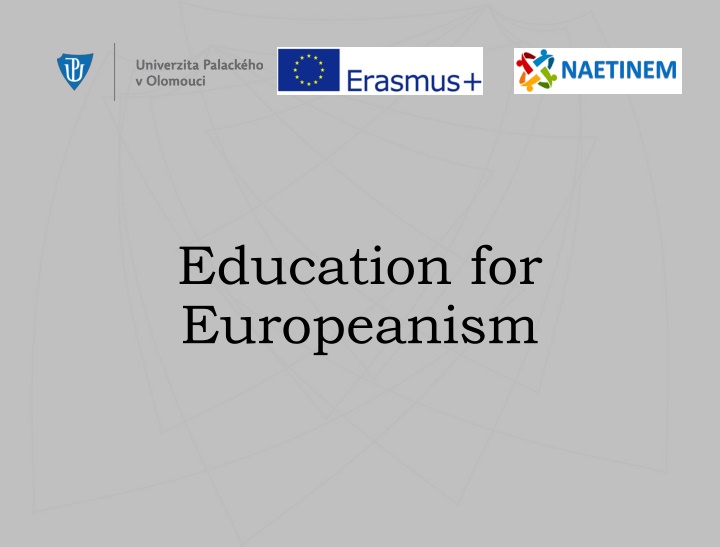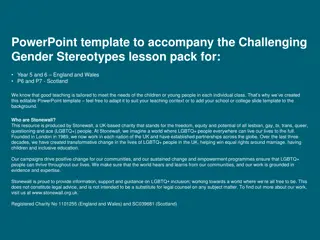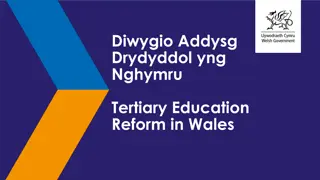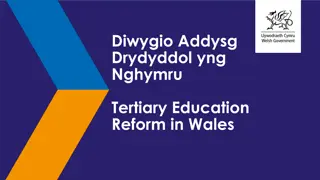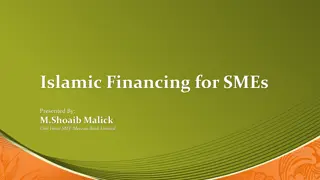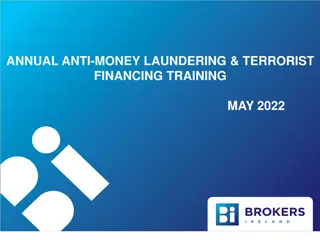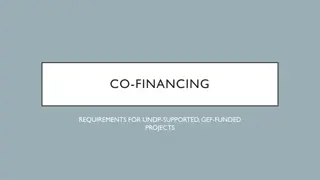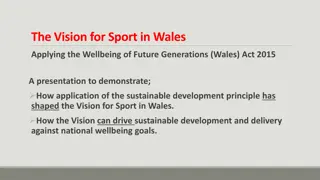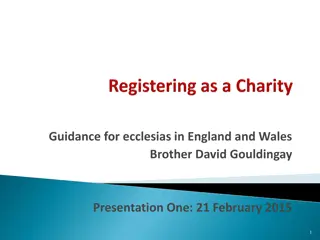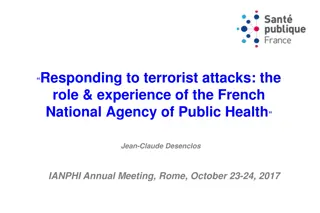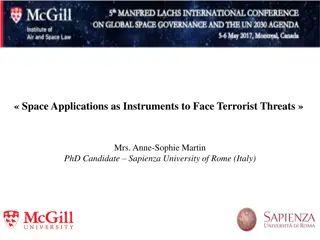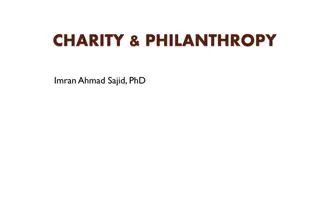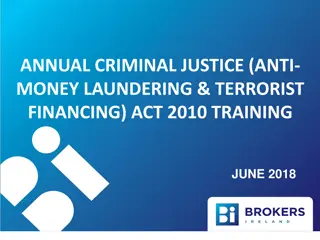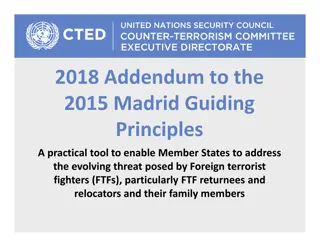Charity Commission for England and Wales: Preventing Terrorist Financing Without Damaging Legitimate Charitable Activity
The Charity Commission for England and Wales focuses on preventing terrorist financing within the charitable sector to maintain public trust. With over 164,000 registered charities and an annual income of around £64 billion, the sector is vulnerable due to its voluntary nature and global impact. Various aspects of terrorist financing, including raising, storing, moving funds, are highlighted, along with international recommendations from the Financial Action Task Force.
Download Presentation

Please find below an Image/Link to download the presentation.
The content on the website is provided AS IS for your information and personal use only. It may not be sold, licensed, or shared on other websites without obtaining consent from the author.If you encounter any issues during the download, it is possible that the publisher has removed the file from their server.
You are allowed to download the files provided on this website for personal or commercial use, subject to the condition that they are used lawfully. All files are the property of their respective owners.
The content on the website is provided AS IS for your information and personal use only. It may not be sold, licensed, or shared on other websites without obtaining consent from the author.
E N D
Presentation Transcript
Education for Europeanism
Roman Empire - - A country that geographically occupied a large portion of Europe Continuing the ancient legacy of the Greek states (Athens) - Latin as a unifying element of the Roman Empire it retained this function into the following period of the European Middle Ages - Roman Law - Roman road network that spanned the empire - Towards the end of the existence of the Roman Empire (3rd-4th century CE) the phenomenon of Christianity
The Frankish Empire of Charlemagne - To a large extent, it continued the legacy of ancient Rome - Christianity as a unifying element - Certain elements of the awareness of a European civilisational community are present here - Cntre of the Empire of Charlemagne in Aachen later the centre of the Holy Roman Empire - In 800, Charlemagne was crowned emperor Pope Leo III
The First "Europeanist" Projects in the Middle Ages These ideas developed mainly in the environment of the Apennine Peninsula and France. - Pierre Du Bois a prominent advisor to King Philip IV the Fair of France, the project of a federation of Christian monarchies - Dante Alighieri a vision of a universal monarchy and subsequently a European "union" of states under Roman patronage - Francesco Petrarca similar project of a wider European monarchy under "Italian" leadership
Charter of King George of Podbrady - Treaty on the Establishment of Peace throughout Christendom project of a Union of European Monarchs initiated by the Bohemian King George of Pod brady - The need to release the Czech state from international isolation following the Hussite Wars and the "counter-offensive" against the Pope Pius II and his efforts to eliminate "heresy" in the Czech lands - George skilfully operates with the Turkish threat in the Balkans and around the Mediterranean that was threatening Christian Europe - The peace delegation, led by the nobleman Lev of Ro mit l, visited most of the European royal courts and received positive and neutral responses.
Charter of King George of Podbrady - The treaty had two parts: - The first part explains in detail the reasons for the proposal and its goals - The second part consists of 23 articles outlining how to prevent war within Europe. - Proposal for the establishment of a union of equal states, which would not interfere in each other's internal affairs and coordinate their policy with the help of agreed-upon mechanisms and bodies: - - - Council of Sovereigns (Consilium) International Court of Justice (Consistorium) General Assembly of Estate Representatives (Congregatio)
The Early Modern Period and the Enlightenment - Erasmus of Rotterdam (1466 1536) numerous reflections on Europeanism, calls for an end to war and proposed project of a peaceful association of European nations - Charles-Ir n e Castel de Saint-Pierre (1658 1743) project of European united states based around a permanent convention of European rulers. Establishment of a European senate respect for the policy of balance and the right to intervene against those who disturb peace - Immanuel Kant (1724 1804) in the work Zum ewigen Frieden (1795), he presented a vision of a federation of European states (republican principles, equality, mutual guarantee of security) - Jean-Jacques Rousseau (1712 1778) and Voltaire (1694 1778) unity of European nations, development of science and culture as the binding matter of European unity
Manifestations and Ideas of Europeanism During the 19th Century - Henri de Saint-Simon (1760 1825) vision of utopian socialism and world (European) peace that would be guaranteed by a federation of European states - Victor Hugo (1802 1885) vision of united European states , a stalwart republican - Karl Marx (1818 1883) sees the future of Europe in proletarian internationalism
European Thought in the 20th Century - League of Nations an international organisation created in response to the events of the Great War. Emphasis on solving European issues - Aristide Briand (1862 1932) memorandum proposing the creation of a European federal union stabilisation of Europe (reconciliation between Germany and France), but without much response. Briand-Kellogg Pact 1928. - PAN-EUROPEAN MOVEMENT associated with Count Richard von Coudenhove-Kalergi (1894 1972). Following the example of the USA, he wanted to create a "United States of Europe" (excluding the Soviet Union and the United Kingdom). - In 1923, Coudenhove-Kalergi and his followers founded the Pan-European Union. This was effectively a forerunner of European integration after the Second World War.
European Integration after 1945 - Council of Europe established on 5 May 1949; response to war events, effort to improve and harmonise relations between individual European states especially in the area of protection of human rights and freedoms (European Convention on Human Rights and Social Charter) - Jean MONNET (1888 1979) initiative for the maximum involvement of West Germany in post-war reconstruction and to integrate the economies of Western European countries - Robert SCHUMAN (1886 1963) French Minister of Foreign Affairs, presented a proposal based on the ideas of Jean Monnet. He suggested that France and the Federal Republic of Germany pool their resources of coal and steel in a new organisation that other European countries could join.
European Integration after 1945 - 9 May 1950 R. Schuman presented the Declaration on New Order of Europe the so-called Schuman Declaration. The European Coal and Steel Community (ESCS) was established (18 April 1951 Paris) and became the basis for future post-war European integration. - The founding members of the European Coal and Steel Community were France, the Federal Republic of Germany, Italy, the Netherlands, Belgium and Luxembourg. Creation of a free trade zone custom-free zone: free movement of persons, goods and capital - In 1953, the European Convention for the Protection of Human Rights and Fundamental Freedoms (Strasbourg Convention) entered into force, to which R. Schuman greatly contributed. After that, R. Schuman made many trips around Europe and advocated for his idea of a united Europe.
European Integration after 1945 - It soon became clear that while economic integration brought the expected benefits, it would be optimal to further deepen the integration. - France and the Federal Republic of Germany Charles de GAULLE (1890 1970) and Konrad ADENAUER (1876 1967) played a key role in this phase of European integration. - Treaties of Rome signed on 25 March 1957 by the representatives of the states belonging to the ECSC. - European Economic Community (EEC) main goals of ensuring a greater degree of economic integration of the member states, including political integration - European Atomic Energy Community (EURATOM) oversight and cooperation in the nuclear industry - In the following decade, the EEC would become the main "driving force" behind European integration.
European Integration in the 60s80s - After 1957, there were effectively three European integration groups that existed side-by-side - European Economic Community EEC - European Coal and Steel Community ECSC - European Atomic Energy Community EURATOM - The question of coordination of their activities initially opposed by France (and its representative Charles de Gaulle), which was pursuing its own policy particularly in the field of agriculture was becoming increasingly clear. - 1967 Consensus is reached and the main decision-making and executive bodies of the EEC, the ECSC and Euratom are merged. The EUROPEAN COMMUNITY EC is established. Headed by the European Commission as its executive body - 1973 - The original six EC countries are joined by the United Kingdom, Ireland and Denmark
European Integration in the 60s80s - The European Parliament originally the legislative body of the EC. The first elections were held in 1979. Seat in Strasbourg - 1981 Greece joins the EC (second enlargement) - 1986 Spain and Portugal join the EC (third enlargement) - The EC becomes the completely dominant integrational unit in Europe, with the integration process accelerating further during the 1980s the adoption of the Single European Act: the state borders between EC member states effectively disappear and the economic union EEC is further strengthened - 1990 East Germany, the former GDR, becomes part of the EC - With its internal development, the EC moves to brink of a political union
European Integration in the 1990s - European Council Summit on 9-10 December 1991 (Maastricht) Approval of a treaty on the closer integration of the EC - 1992 7 February, signing of Maastricht Treaty (Foreign, Finance and Economy Ministers) by the then 12 EC members - Establishment of the EUROPEAN UNION EU - shared foreign and security policy - coordination in the areas of justice and other internal affairs - strengthening of economic union and preparing for the introduction of a monetary union - major bolstering of the competencies of the European Parliament in Strasbourg - On 7 April 1992, the Maastricht Treaty was approved by the European Parliament and subsequently approved by each Member State - The Maastricht Treaty entered into force on 1 January 1993
European Integration in the 1990s - 1995 The fourth wave of EU enlargement took place: Austria, Finland and Sweden (since 1 January 1995) - 2004 The fifth wave of EU enlargement took place: the Czech Republic, Slovakia, Poland, Hungary, Slovenia, Estonia, Lithuania, Latvia, Cyprus and Malta (since 1May 2004) - 2007 The sixth wave of EU enlargement took place: Romania and Bulgaria (since 1 January 2007) - 2013 Seventh enlargement of the EU: Croatia (since 1 July 2013)
Schengen Agreement - On 14 June 1985, an agreement was concluded between France, Germany and the Benelux countries in Schengen, Luxembourg, on the gradual abolition of customs and passport checks. - 1990 19 June, the Convention Implementing the Schengen Agreement was signed defining of the so-called Schengen Area, principles and rules laid down, jointly referred to as the Schengen acquis. Border checks between signatory states were abolished in March 1995. - Based to the Treaty of Amsterdam of October 1997 regulating the functioning of the EU, the Schengen Treaty was incorporated into the legal system of the European Union in 1999, when the Treaty of Amsterdam entered into force. - Since March 1995, other EU countries have been gradually entering the Schengen area the Czech Republic entered in 2007
European Parliament - Since 1952 ECSC Common Assembly - 1962 The ECSC Common Assembly is transformed into the European Parliament - 1979 - The first direct elections to the European Parliament are held - The role of the EP is further specified in the framework of the Maastricht Treaty - EP the legislative body of the European Union, MEPs elected for a five- year term (most recent elections 23-26 May 2019) - The EP meets in Strasbourg (plenary), secretariat in Luxembourg, EP committees in Brussels
European Parliament - The European Parliament performs three main functions: - LEGISLATIVE - approves EU regulations - decides on issues of international agreements - decides on EU enlargement - oversees the activities of the European Commission - SUPERVISORY - exercises control over all EU institutions - elects the President of the European Commission - comments on petitions submitted by EU citizens and opens investigations - discusses monetary policy with the European Central Bank - interpellates the European Commission and the European Council - BUDGETARY - draws up the EU budget with the Council of the European Union - approves the long-term EU budget
European Commission - The European Commission is a politically independent executive body of the European Union based in Brussels. It promotes the general interests of the EU it proposes and enforces legislation, implements policies and implements the EU budget - Roles of the EC: - submits proposals for new legislation - manages EU policies and allocates funds from the EU budget - enforces EU law - represents the European Union abroad - Composition: - political leadership is provided by a team of 27 Commissioners headed by the President of the Commission - the College of Commissioners consists of the President of the Commission and 7 Vice-Presidents. Applied principle of collective decision-making, independence of individual Commissioners
The Court of Justice of the EU - Monitors (and ensures) compliance of EU legislation with application. It can repeal measures of the EC, national governments and the EU Council of Ministers that prove to be in conflict with EU legislation. - Interprets EU law so that it is applied in the same way in all EU states, and settles legal disputes between individual states and EU institutions. - At the request of the courts of each member state, the ECJ adopts binding resolutions on the validity and interpretation of the provisions of EU law - Seat in Luxembourg - Composition: - Court of Justice: 1 judge per Member State and 11 advocates general - General Court: two judges per Member State
The Court of Justice of the EU Mission of the Court of Justice of the EU: The Court of Justice of the EU makes judgements on cases brought before it. The most common types of cases are the following: - interpretation of the law - enforcement of the law - repealing of EU legislation - ensuring action by the EU institutions - penalties against EU institutions
Czech Republics Road to the EU - 1991 signing of the association agreement between Czechoslovakia (CSFR) and the EC on 16 December 1991 - The establishment of the Czech Republic in 1993 meant the need to implement a new association agreement. It entered into force on 1 February 1995. - 17 January 1996 official submission of the Czech Republic's application to join the European Union (V. Klaus) - 1997 1999 intensive accession negotiations between the Czech Republic and the EU (1998 submission of the National Programme for the Preparation of the Czech Republic for EU Membership) - 7-11 December 2000 EU Summit in Nice formulation of representation of the Czech Republic as a future member of the EU.
Czech Republics Road to the EU - 12-13 December 2002 EU summit in Copenhagen. Decision on the accession of the Czech Republic into the EU framework - The conclusions of the Copenhagen summit were subsequently approved by the European Council and European Commission, 16 April 2003 Signing of the Treaty of Accession to the EU V. pidla and V. Klaus - The Czech Republic, together with nine other countries (Slovakia, Poland, Hungary, Slovenia, Estonia, Latvia, Lithuania, Cyprus and Malta), became members of the European Union on 1 May 2004 - The Czech Republic has adequate representation in all EU institutions the European Council, the Commission, the European Parliament (21 seats), the Court of Justice of the EU and others - Commitment to join the so-called Eurozone (growing support within the Czech Republic)
